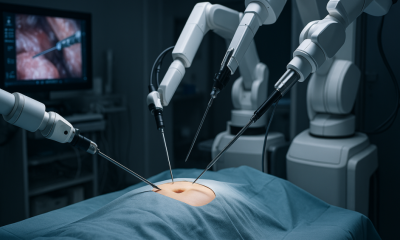Robotics
Figure AI’s Journey to Robotics Dominance with BMW, Microsoft, and OpenAI Support

In the dynamic landscape of robotics and artificial intelligence, Figure AI has emerged as a trailblazer with its groundbreaking humanoid robots. As a pioneer in the industry, the company is drawing significant attention for its innovative approach to robotics, particularly in the realm of autonomous humanoid workers. Figure AI's recent developments, including a strategic partnership with BMW and substantial funding talks, signal a transformative shift not only in the robotics sector but also across various industries.
Partnership with BMW and Industry Impact
Figure AI's partnership with BMW represents a groundbreaking shift in industrial automation, introducing humanoid robots to BMW's manufacturing plants, starting in Spartanburg, South Carolina. This collaboration signifies a significant move towards integrating more human-like automation in industries traditionally dominated by conventional machinery.
The deployment of these humanoid robots in automotive manufacturing is poised to have far-reaching implications. Their ability to perform tasks that are challenging or hazardous for humans, along with their operation in difficult-to-access areas, could greatly enhance efficiency and productivity. This move is partly driven by the need to adapt to rapidly evolving car production demands and manage rising labor costs.
However, the integration of humanoid robots in manufacturing also raises crucial questions about the labor market. These robots, capable of executing tasks traditionally performed by humans, could impact employment dynamics and skill requirements in the automotive industry and beyond. Balancing automation with human labor is a key challenge that companies like BMW and Figure AI will need to address.
Overall, this initiative marks a significant stride in the field of robotics, reflecting a growing trend of utilizing humanoid robots for diverse applications. As the technology behind these robots continues to advance, their broader operational and labor market impacts across various industries will be a critical area to watch.
Funding and Valuation: Positioning Figure AI in the Robotics Market
Figure AI's recent funding round, led by Parkway Venture Capital, marks a significant milestone in the company's journey in the robotics market. This funding round, coupled with the interest from tech giants like Microsoft and OpenAI in the realm of $500 million, underscores the growing importance of humanoid robotics in the AI and automation space.
The infusion of capital from such major players in the tech industry is a strong vote of confidence in Figure AI's technology and its potential applications. This funding not only bolsters the company's financial standing but also positions it as a key player in the rapidly evolving robotics market. Microsoft and OpenAI's involvement suggests that Figure AI's approach to humanoid robotics aligns with broader industry trends towards more sophisticated, human-like AI systems.
The current market valuation of Figure AI, potentially reaching the status of a “unicorn” company, is significant. It reflects the high expectations and optimism surrounding the capabilities and future applications of humanoid robots. This valuation is indicative of the broader investment trends in AI and robotics, where there is a clear shift towards more advanced, versatile, and human-compatible robotic solutions.
In the context of the robotics industry, Figure AI's funding and valuation highlight the growing emphasis on humanoid robots that can perform a wide range of tasks, from manufacturing to healthcare. The trend suggests that investors are looking beyond traditional automation solutions, focusing instead on more adaptable, intelligent, and human-like robots. As such, Figure AI's trajectory and market positioning offer a glimpse into the future direction of the robotics and AI industries, where human-like versatility and intelligence become key differentiators.
In the long term, humanoid robotics could profoundly transform the job market and society. While they offer the potential to take over mundane or dangerous tasks, freeing humans for more creative and complex work, there's also the possibility of increasing unemployment in certain sectors. The integration of humanoid robots into daily life and industry will likely be a gradual process, marked by ongoing adjustments to address these challenges and fully realize the benefits of this advanced technology.











